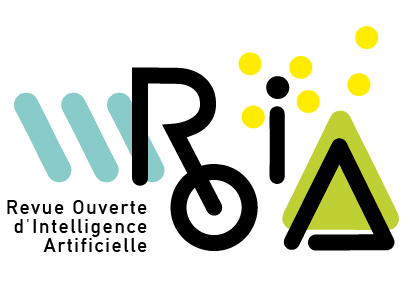Nous proposons une nouvelle architecture d’agent d’inspiration sociale adaptée à un système d’aide à la décision pour résoudre un problème de génération de structures de coalitions distribué avec chevauchements pour la conception de produits dans le cadre de l’économie circulaire. Cette architecture centrée agent permet aux agents de savoir avec quelles accointances former une coalition de manière à designer des produits répondant au mieux à un besoin utilisateur. Le mécanisme cognitif utilisé par l’architecture ABSG s’inspire des principes de l’attraction des sciences humaines et sociales.
We propose a new socially inspired agent architecture adapted to a decision support system to solve a distributed problem of coalitions structure generation for product design in the circular economy. This agent-centric architecture allows agents to know with whom to form a coalition. The cognitive mechanism used by the ABSG architecture is inspired by the principles of attraction from the human and social sciences. We argue that a multi-agent paradigm and a social approach are suitable solutions for solving open and dynamic coalition formation problems. We assess this assumption by using a study case from industry
Accepté le :
Publié le :
Keywords: Isotriviality, log-selfishness, Machine.
Mickaël Bettinelli 1 ; Michel Occello 2 ; Damien Genthial
 CC-BY 4.0
CC-BY 4.0
@article{ROIA_2023__4_2_9_0,
author = {Micka\"el Bettinelli and Michel Occello and Damien Genthial},
title = {ABSG~: une architecture d{\textquoteright}agents d{\textquoteright}inspiration sociale pour le probl\`eme de formation de coalitions},
journal = {Revue Ouverte d'Intelligence Artificielle},
pages = {9--40},
publisher = {Association pour la diffusion de la recherche francophone en intelligence artificielle},
volume = {4},
number = {2},
year = {2023},
doi = {10.5802/roia.55},
language = {fr},
url = {https://roia.centre-mersenne.org/articles/10.5802/roia.55/}
}
TY - JOUR AU - Mickaël Bettinelli AU - Michel Occello AU - Damien Genthial TI - ABSG : une architecture d’agents d’inspiration sociale pour le problème de formation de coalitions JO - Revue Ouverte d'Intelligence Artificielle PY - 2023 SP - 9 EP - 40 VL - 4 IS - 2 PB - Association pour la diffusion de la recherche francophone en intelligence artificielle UR - https://roia.centre-mersenne.org/articles/10.5802/roia.55/ DO - 10.5802/roia.55 LA - fr ID - ROIA_2023__4_2_9_0 ER -
%0 Journal Article %A Mickaël Bettinelli %A Michel Occello %A Damien Genthial %T ABSG : une architecture d’agents d’inspiration sociale pour le problème de formation de coalitions %J Revue Ouverte d'Intelligence Artificielle %D 2023 %P 9-40 %V 4 %N 2 %I Association pour la diffusion de la recherche francophone en intelligence artificielle %U https://roia.centre-mersenne.org/articles/10.5802/roia.55/ %R 10.5802/roia.55 %G fr %F ROIA_2023__4_2_9_0
Mickaël Bettinelli; Michel Occello; Damien Genthial. ABSG : une architecture d’agents d’inspiration sociale pour le problème de formation de coalitions. Revue Ouverte d'Intelligence Artificielle, Post-actes des Journées Francophones sur les Systèmes Multi-Agents (JFSMA 2021), Volume 4 (2023) no. 2, pp. 9-40. doi : 10.5802/roia.55. https://roia.centre-mersenne.org/articles/10.5802/roia.55/
[1] Ordinal approximation for social choice, matching, and facility location problems given candidate positions, ACM Transactions on Economics and Computation (TEAC), Volume 9 (2021) no. 2, 9, 24 pages | DOI | MR
[2] When cellular meets WiFi in wireless small cell networks, IEEE communications magazine, Volume 51 (2013) no. 6, pp. 44-50 | DOI
[3] Coalition Formation Problem : a Group Dynamics Inspired Swarming Method (2020) (HAL preprint https://hal.science/hal-02903531)
[4] A decision support framework for remanufacturing of highly variable products using a collective intelligence approach, Procedia CIRP, Volume 90 (2020), pp. 594-599 | DOI
[5] Une approche d’intelligence collective pour la conception d’un système d’aide à la décision appliqué à l’économie circulaire, thèse de doctorat, Université Grenoble Alpes (2021)
[6] Algorithms for graph-constrained coalition formation in the real world, ACM Transactions on Intelligent Systems and Technology (TIST), Volume 8 (2017) no. 4, 60, 24 pages | DOI
[7] Handbook of computational social choice, Cambridge University Press, 2016 | DOI
[8] ODSS : Efficient Hybridization for Optimal Coalition Structure Generation., AAAI, Volume 34 (2020), pp. 7079-7086 | DOI
[9] Stability in the hospitals/residents problem with couples and ties : Mathematical models and computational studies, Omega, Volume 103 (2020), 102386 | DOI
[10] Correlation clustering based coalition formation for multi-robot task allocation, Proceedings of the 34th ACM/SIGAPP Symposium on Applied Computing (2019), pp. 906-913 | DOI
[11] A hierarchical clustering approach to large-scale near-optimal coalition formation with quality guarantees, Engineering Applications of Artificial Intelligence, Volume 59 (2017), pp. 170-185 | DOI
[12] Group dynamics, Cengage Learning, 2010
[13] College admissions and the stability of marriage, The American Mathematical Monthly, Volume 69 (1962) no. 1, pp. 9-15 | DOI | MR | Zbl
[14] Swarm aggregations using artificial potentials and sliding-mode control, IEEE Transactions on Robotics, Volume 21 (2005) no. 6, pp. 1208-1214 | DOI
[15] Predicting social and personal attraction in task groups, Groupwork, Volume 23 (2013) no. 1, pp. 73-93 | DOI
[16] PSO-based strategy for the segregation of heterogeneous robotic swarms, Journal of Computational Science, Volume 31 (2019), pp. 86-94 | DOI
[17] Multi-agent simulation framework for large-scale coalition formation, 2016 IEEE/WIC/ACM International Conference on Web Intelligence (WI), IEEE (2016), pp. 343-350 | DOI
[18] A many-to-many ‘rural hospital theorem’, Journal of Mathematical Economics, Volume 54 (2014), pp. 63-73 | DOI | MR | Zbl
[19] Segregation of Heterogeneous Units in a Swarm of Robotic Agents, IEEE Transactions on Automatic Control, Volume 55 (2010) no. 3, pp. 743-748 | DOI | MR | Zbl
[20] The Soar User’s Manual Version 9.5.0 (2015) (Technical report)
[21] Group cohesiveness as interpersonal attraction : A review of relationships with antecedent and consequent variables, Psychological bulletin, Volume 64 (1965) no. 4, pp. 259-309 | DOI
[22] Hospitals/residents problem, Encyclopedia of Algorithms, Springer, Boston, MA, 2008, pp. 390-394 | DOI
[23] A hybrid exact algorithm for complete set partitioning, Artificial Intelligence, Volume 230 (2016), pp. 14-50 | DOI | MR | Zbl
[24] Affectation distribuée d’individus à des activités avec des préférences additivement séparables, Journées Francophones sur les Systèmes Multi-Agents, Cépaduès édition (2017), pp. 19-28
[25] An avatar architecture for the web of things, IEEE Internet Computing, Volume 19 (2015) no. 2, pp. 30-38 | DOI
[26] Towards agent-based coalition formation for service composition, 2006 IEEE/WIC/ACM International Conference on Intelligent Agent Technology, IEEE (2006), pp. 73-80 | DOI
[27] Some varieties of interpersonal attraction, Festschrift for Gardner Murphy, Harper, 1960, pp. 171-182
[28] A branch-and-bound approach to the traveling salesman problem with a drone, INFORMS Journal on Computing, Volume 31 (2019) no. 2, pp. 335-346 | DOI | MR | Zbl
[29] Efficient Contract-Net Protocol For Formal Modeling Of Multi-Agent Systems, International Journal of Computing and Digital Systems, Volume 10 (2021), pp. 805-816 | DOI
[30] Coalition structure generation : A survey, Artificial Intelligence, Volume 229 (2015), pp. 139-174 | DOI | MR | Zbl
[31] An anytime algorithm for optimal coalition structure generation, Journal of artificial intelligence research, Volume 34 (2009), pp. 521-567 | DOI | MR | Zbl
[32] Self-Adapting Coalition Formation Among Electric Vehicles in Smart Grids, 2013 IEEE 7th International Conference on Self-Adaptive and Self-Organizing Systems (2013), pp. 11-20 | DOI
[33] Hedonic coalition formation for distributed task allocation among wireless agents, IEEE Transactions on Mobile Computing, Volume 10 (2010) no. 9, pp. 1327-1344 | DOI
[34] Cohesion and segregation in swarm navigation, Robotica, Volume 32 (2014) no. 2, pp. 209-223 | DOI
[35] Collective dynamics of swarms with a new attraction/repulsion function, Mathematical Problems in Engineering, Volume 2011 (2011), 735248, 14 pages | DOI | MR | Zbl
[36] Reciprocal n-body collision avoidance, Robotics research, Springer, 2011, pp. 3-19 | DOI | Zbl
[37] Market-based multi-robot coalition formation, Distributed Autonomous Robotic Systems 7, Springer, 2006, pp. 227-236 | DOI | Zbl
[38] Importance of physical attractiveness in dating behavior, Journal of personality and social psychology, Volume 4 (1966) no. 5, pp. 508-516 | DOI
[39] Overlapping coalition formation games for emerging communication networks, IEEE Network, Volume 30 (2016) no. 5, pp. 46-53 | DOI
[40] A dynamic programming approach to the complete set partitioning problem, BIT Numerical Mathematics, Volume 26 (1986) no. 4, pp. 467-474 | DOI | MR | Zbl
Cité par Sources :

